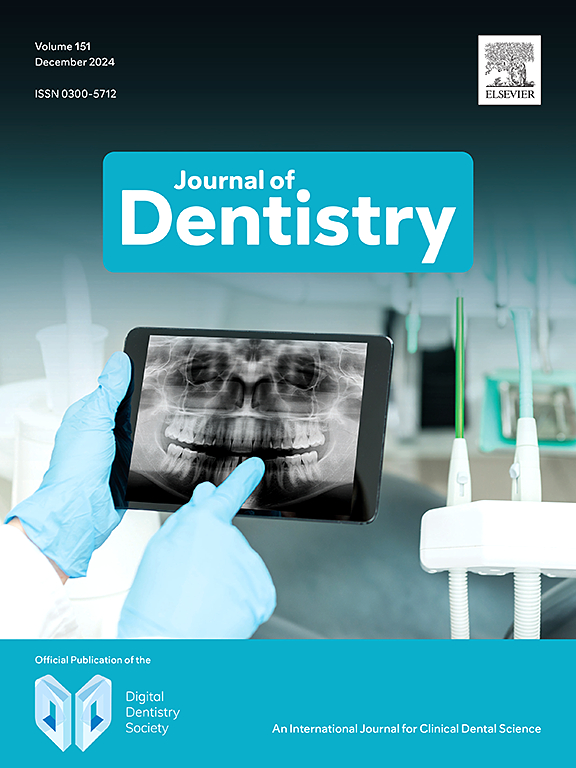Assessment of clinical reproducibility for intraoral scanning on different anatomical regions for the complete maxillary edentulous arch with two intraoral scanners
IF 4.8
2区 医学
Q1 DENTISTRY, ORAL SURGERY & MEDICINE
引用次数: 0
Abstract
Objectives
There are no in vivo studies comparing multiple intraoral scanners (IOSs) for the completely edentulous maxilla to polyvinyl siloxane (PVS) impressions. Investigations comparing IOSs to PVS impressions focus on comparing the overall scan and not individual anatomical regions. This study aims to evaluate two IOSs and compare the results for different anatomical regions on the completely edentulous maxillary arch.
Materials and methods
Nineteen patients were recruited with a completely edentulous maxilla. A custom tray was constructed, and a sectional border moulded PVS impression was made then scanned. An intraoral scan of the edentulous maxilla with a Trios 4 (3Shape, B/V) and Medit i700 (Medit corporation) was then captured. The scans were analysed for negative and positive surface deviations along with root mean square for distinct anatomical regions compared to the polyvinyl siloxane impression. A two-way ANOVA followed by Tukey HSD post hoc tests for each scanner was conducted for all anatomical regions to determine differences between the regions.
Results
There was no significant difference between the two IOSs included in this study for all anatomical regions or for the overall scan (0.435, 0.38), palatal vault (0.18, 0.181), ridge (0.218, 0.209), and post dam (0.233, 0.229) anatomical regions. Significantly higher deviation (p < 0.05) was observed for the peripheral regions (0.607, 0.557) for each intraoral scanners Trio 4 and Medit i700.
Conclusion
Different IOSs can capture all areas of a completely edentulous maxilla consistently, when compared to a PVS impression, apart from the peripheries.
Clinical significance
Care should be taken when scanning the peripheries. These regions are problematic to capture with an IOS. Border moulding should still be considered the optimal impression technique for the completely edentulous maxilla. The IOSs investigated did not make a difference for the anatomical regions investigated.
使用两台口内扫描仪对完整上颌无牙弓的不同解剖区域进行口内扫描的临床重现性评估。
目的:目前还没有对完全无牙上颌骨的多种口内扫描仪与聚乙烯硅氧烷印模进行比较的活体研究。将口内扫描仪与聚乙烯硅氧烷印模进行比较的研究侧重于比较整体扫描,而不是个别解剖区域。本研究旨在评估两种口内扫描仪,并比较完全无牙颌弓不同解剖区域的扫描结果:招募了 19 名上颌全缺失患者。制作了一个定制托盘,并制作了一个分段边界模制聚乙烯硅氧烷印模,然后进行扫描。然后用 Trios 4(3Shape,B/V)和 Medit i700(Medit 公司)对无牙上颌骨进行口内扫描。与聚乙烯硅氧烷印模相比,扫描结果分析了不同解剖区域的负表面偏差和正表面偏差以及均方根。对每个扫描仪的所有解剖区域进行双向方差分析,然后进行 Tukey HSD 事后检验,以确定各区域之间的差异:本研究中的两种口内扫描仪在所有解剖区域或整体扫描(0.435, 0.38)、腭穹(0.18, 0.181)、嵴(0.218, 0.209)和坝后(0.233, 0.229)解剖区域方面均无明显差异。偏差显著较高(p结论:与聚乙烯硅氧烷印模相比,不同的口内扫描仪可以一致地捕捉完全无牙颌的所有区域,除了边缘区域:临床意义:扫描边缘时应小心谨慎。临床意义:在扫描边缘时应小心,这些区域很难用口内扫描仪捕捉到。对于全口无牙的上颌骨,边模仍然是最佳的印模技术。所研究的口内扫描仪对所研究的解剖区域没有影响。
本文章由计算机程序翻译,如有差异,请以英文原文为准。
求助全文
约1分钟内获得全文
求助全文
来源期刊

Journal of dentistry
医学-牙科与口腔外科
CiteScore
7.30
自引率
11.40%
发文量
349
审稿时长
35 days
期刊介绍:
The Journal of Dentistry has an open access mirror journal The Journal of Dentistry: X, sharing the same aims and scope, editorial team, submission system and rigorous peer review.
The Journal of Dentistry is the leading international dental journal within the field of Restorative Dentistry. Placing an emphasis on publishing novel and high-quality research papers, the Journal aims to influence the practice of dentistry at clinician, research, industry and policy-maker level on an international basis.
Topics covered include the management of dental disease, periodontology, endodontology, operative dentistry, fixed and removable prosthodontics, dental biomaterials science, long-term clinical trials including epidemiology and oral health, technology transfer of new scientific instrumentation or procedures, as well as clinically relevant oral biology and translational research.
The Journal of Dentistry will publish original scientific research papers including short communications. It is also interested in publishing review articles and leaders in themed areas which will be linked to new scientific research. Conference proceedings are also welcome and expressions of interest should be communicated to the Editor.
 求助内容:
求助内容: 应助结果提醒方式:
应助结果提醒方式:


